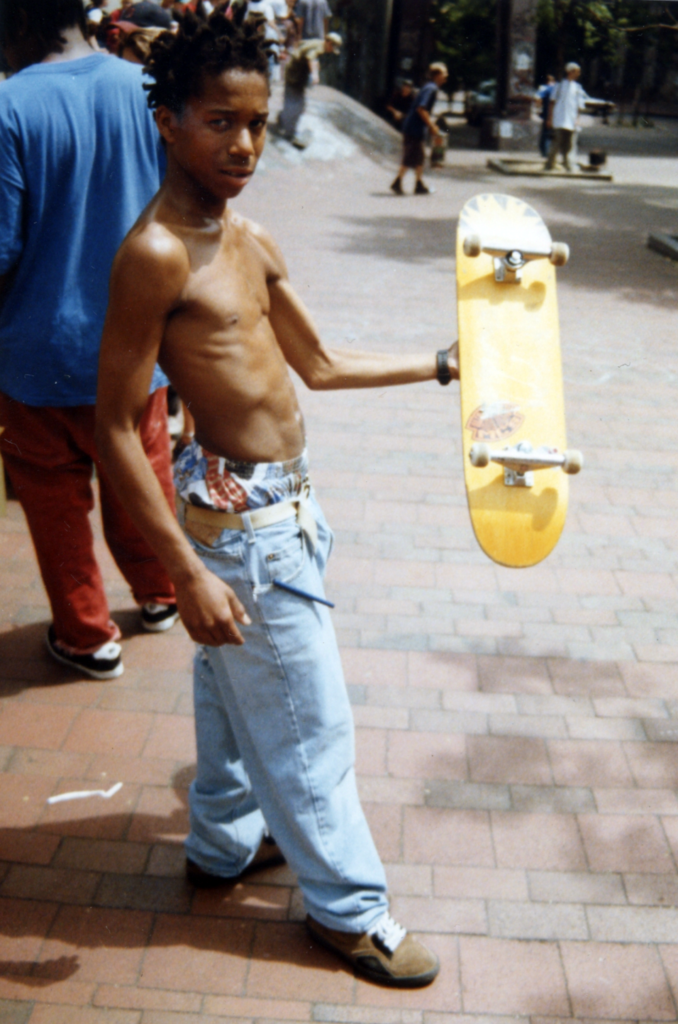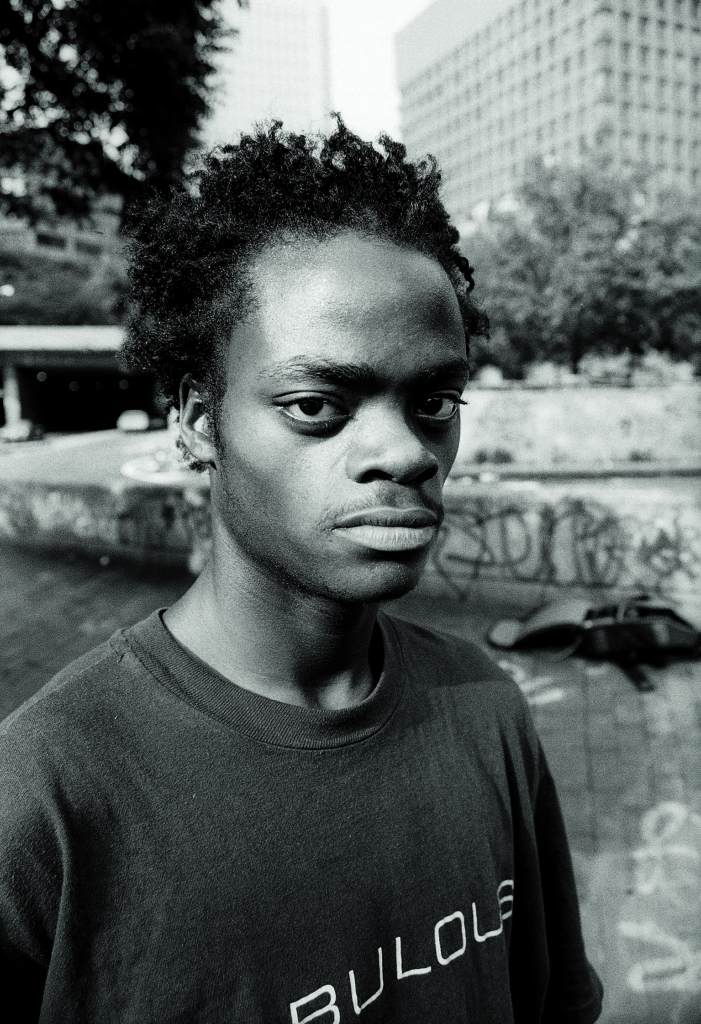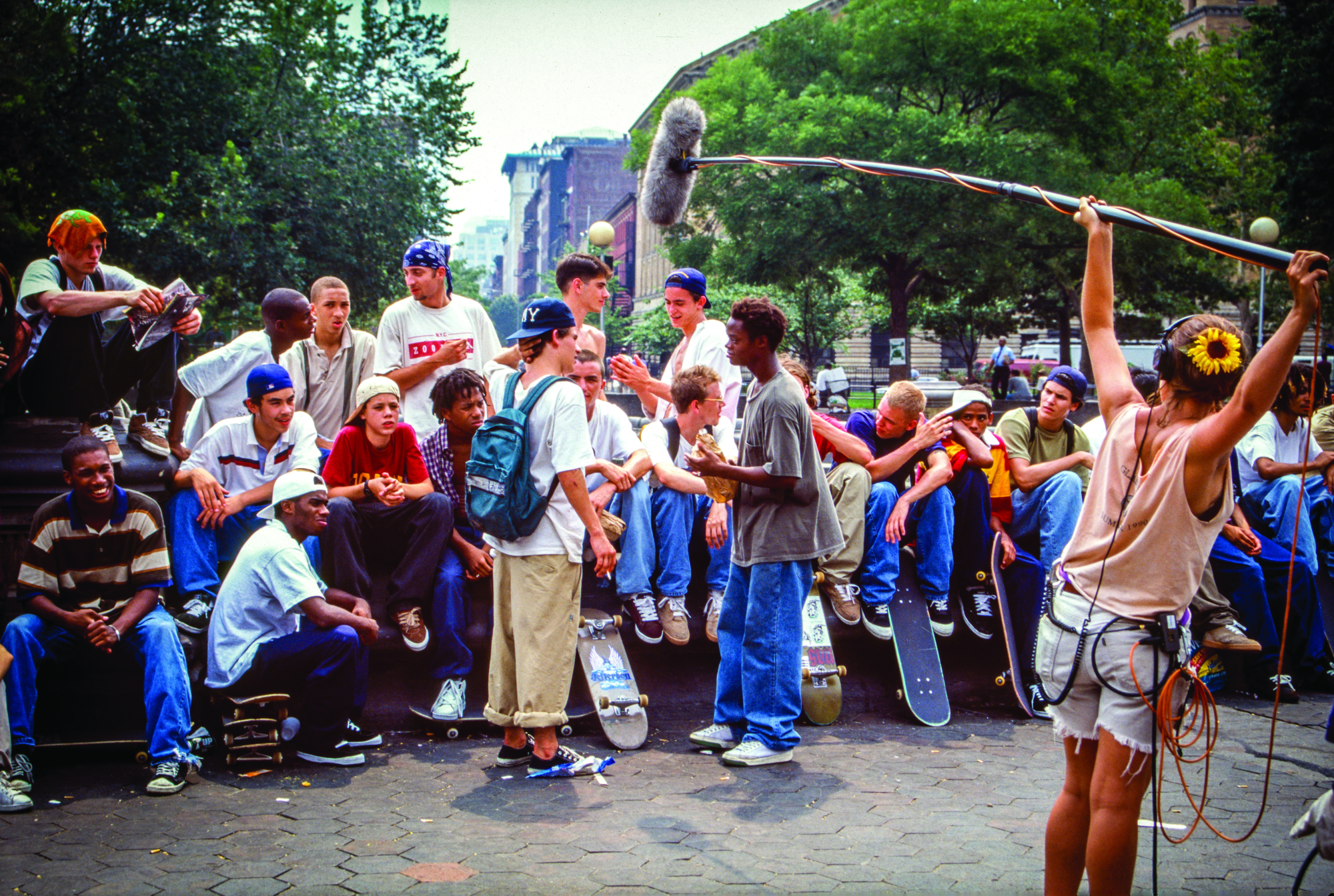Editor’s note: since publication, Martin’s documentary has been retitled We Were Once Kids. This article retains the original title used at the film’s initial festival screenings in 2021.
It is hard to believe that it has been twenty-six years since the release of United States photographer-turned-director Larry Clark’s cult feature film Kids (1995). Adopting a documentary aesthetic, Clark presented a shocking coming-of-age film set among a New York City skateboarding subculture, with scenes of drug-taking, underage sex and violence abounding. The film’s narrative follows the quest of wisecracking adolescent Telly (Leo Fitzpatrick) to deflower two virgins in one day. Meanwhile, his past conquest Jennie (Chloë Sevigny) discovers that she is HIV-positive, a result of her brief encounter with him. She spends a good part of the film seeking Telly out, creating the film’s unnerving central question: will she find him before he unknowingly infects his next victim? The film’s slight narrative ends when Telly’s drug-fuelled friend Casper (Justin Pierce) rapes Jennie, a devastating act that emphasises the amorality of the film’s characters.
Dividing critics and audiences across the globe, the controversial project launched the careers of actors Sevigny and Rosario Dawson, as well as that of writer/director Harmony Korine, who scripted the film at the age of nineteen. Rewatching scenes of Kids in contemporary times, it is difficult to imagine that it would find widespread release if it were made now (the film was picked up for distribution by The Weinstein Company, and went on to gross over US$20 million at the international box office). With filmmaking ethics having been recently re-examined thanks to social movements such as #MeToo, and with the advent of intimacy coordinators on sets, there are several sex scenes that would be considered too problematic for twenty-first century distributors and audiences. Even in 1995, some critics were scathing. Writing for The Washington Post, Rita Kempley described Kids as ‘virtually child pornography disguised as a cautionary documentary’,[1]Rita Kempley, ‘Kids (NR)’, The Washington Post, 25 August 1995, <https://www.washingtonpost.com/wp-srv/style/longterm/movies/videos/kidsnrkempley_c029f5.htm>, accessed 2 August 2021. while Chris Hicks echoed the views of many on the religious right by referring to the film as ‘pretentious exploitation’ in a review for the Mormon-aligned Deseret News.[2]Chris Hicks, ‘Film Review: Kids’, The Deseret News, 15 August 1995, <https://www.deseret.com/1995/8/15/20087990/film-review-kids>, accessed 2 August 2021. Certainly, Kids raises questions for the discerning viewer such as: Just how young were the teenage actors in the coercive sex scenes? Are those real drugs that the kids were smoking? Were there any parents or guardians on set?
More than two decades later, a new Screen Australia–backed documentary, The Kids (Eddie Martin, 2021) sets out to provide answers to these questions. Over the course of around ninety minutes, the documentary suggests that many of the adolescents who featured in Kids were, in fact, exploited by Clark and then abandoned to deal with the fallout of their sudden fame – with, in some cases, tragic consequences.
The Kids is a passion project for Hamilton Harris, one of the many young non-professional actors from the 1995 film who has sought healing in the aftermath of its success. Harris co-wrote and co-produced the documentary with Martin, and also features as the film’s main narrator. In an interview for Variety, he describes his long quest to bring the project to fruition, and how, upon meeting Martin – who had previously helmed documentaries on street artists and the world of professional skateboarding – he felt confident that he had found the right director. ‘When I met Eddie, I knew he would allow me to be at my most vulnerable,’ he explains, ‘and I can’t do that if I feel like I’m going to be taken advantage of or put down or used.’[3]Hamilton Harris, quoted in Brent Lang, ‘26 Years After Kids Shocked the World, a New Documentary Examines the Lives It Shattered’, Variety, 12 June 2021, <https://variety.com/2021/film/news/kids-new-documentary-larry-clark-harmony-korine-1234995023/>, accessed 12 June 2021. Notably, the documentary gives substantial time to Harris’ recollections of and feelings towards Clark’s film.

Like several of the other actors who appeared in Kids, Harris was a member of a tight-knit New York City skateboarding community in the 1980s and 1990s. The Kids begins with an exploration of this subculture and the backgrounds of its members. Harris describes his birth into abject poverty in a New York City housing project in the 1970s, and the lack of ‘material opportunities’ that were available in such surroundings. Similarly to many of his friends, he witnessed drug abuse at home by close family members. As he describes in the documentary, skateboarding provided a much-needed means of escape: ‘A skateboard is something that you get on and you can ride away from something going on at home.’ A Lower East Side skate shop and a nearby park – seen in the documentary in amateur archival video footage and photographs – presented a hub and refuge for him and many of the other youngsters in his circle. In this oasis, camaraderie and trust developed, with fellow interviewee Jamal Simmons describing in the documentary how the skater kids of the surrounding neighbourhoods ‘gravitated towards each other’. When the skate shop closed down in the early 1990s, the group took to the streets; it was there that Harris met and got to know Pierce, a homeless runaway. The Kids features contemporaneous archival video footage of Pierce and his friends partying, drinking and taking drugs in squalid surroundings, images that closely resemble scenes from Clark’s film. While several of the documentary interviewees testify to the trauma of their upbringings and the precarity of their day-to-day existence as adolescents, Harris laments the fact that Kids does not capture the way they supported one another through this tumultuous period in their lives.
The overall impression becomes that of a shocking lack of care for the young actors, many of whom did not understand the bigger picture of the project they were participating in.
As The Kids documents, Korine – then a film school student at New York University – first connected with the skateboarding community through the sociable and charismatic Harold Hunter, who was a leader within the group. Interviewees recall that, around the same time, the fiftysomething Clark also appeared on the scene, dressed in baggy clothing so as to fit in with the youthful crowd. He was vouched for by skater and photographer Tobin Yelland, who had met Clark when he was a high school junior and was cognisant of his fame as a photographer. Harris and other interviewees allege that, over a number of years, the director offered them and other adolescents drugs as a way of accessing the community while researching his film project. When the opportunity to act in Kids arrived, Hunter and Pierce were among the first to attend casting sessions, both obtaining major roles in the film. Their involvement, as well as offers of small amounts of money, drove many of their peers to also participate in the project. Harris describes his surprise, when attending a casting session, at being handed a script that contained a character with his own name; essentially, he was being asked to play himself. As he matter-of-factly recounts, ‘I read the part and I got the part.’

The testimony of Harris and other actors who participated in the filming of Kids is damning regarding Clark’s conduct as director. They describe his capturing of real adolescent drug use, meaning that many actors were under the influence while on camera. Non-professional actor Jon Abrahams recalls feeling pressure to perform an intimate act with a female co-star during the film’s final party scene, while Harris describes how Pierce – for whom Clark had become a sort of parental figure in place of the biological father he had never known[4]A final story strand in the documentary concerns the discovery of Pierce’s biological father, Australian Michael Hayes, who did not learn of the existence of his son until after his death. While touching, this narrative thread feels somewhat irrelevant to the documentary’s core narrative. – revolted as filming drew to a close, drinking heavily and at one point being arrested for violent behaviour. The overall impression becomes that of a shocking lack of care for the young actors, many of whom did not understand the bigger picture of the project they were participating in.
Upon the completion of Kids, the young stars were invited to a private screening in Tribeca followed by a buffet. Abrahams describes how, at this venue, the actors received ‘bonus cheques’ of US$1000 each, an agreement that locked them out of any future profits generated by the film. Later, when Kids became a smash hit, resentment set in for many of the participants, as well as shock that their negative portrayals as amoral street kids were on global display. Harris recalls watching the film in a local theatre with a public audience and being troubled by a scene in which he presents a tutorial on how to roll a joint. ‘It was too overwhelming for me – it didn’t feel real, and I felt somewhat exposed,’ he expresses.
The most tragic chapter in the documentary’s story takes place in the years following Kids’ release. Finding critical acclaim for his performance, Pierce pursued an acting career in Los Angeles, where he was visited by his friends and co-stars. While both Pierce and Hunter found some success in their new profession, they struggled with their sudden fame and the challenge of navigating the industry without parental support or any real form of guidance. Pierce died by suicide in 2000, while Hunter overdosed in 2006, having turned to drugs and alcohol after his few film roles dried up. The last third of the documentary charts the years leading up to their deaths, and captures the grief of the friends they left behind. Recalling Hunter’s death and his search for meaning in the aftermath, Harris exclaims, ‘This is wiping years from my face – years of pain, years of lessons.’ The making of the documentary has not only served to chart his past, he suggests, but also provided a means for him to move forward after these tragedies. In this sense, his experience of filmmaking has come full circle, with the therapeutic exercise of participating in this film somewhat addressing the psychological trauma bought about by the earlier one.
As a whole, The Kids is an engaging and affective expository work that successfully weaves together a tale of neglected and vulnerable kids from broken homes who were taken advantage of for the sake of art and financial gain. The archival material from the late 1980s and 1990s that the makers have assembled, including video footage of casual encounters between Clark and the skateboarding crew, is impressive and illuminating. While Harris’ voice dominates the film, there are plenty of other testimonies to corroborate the experience he describes, and nothing offered to refute it (Clark and Korine were approached to participate in the documentary, but refused).
There is no doubt that, as a cultural work, Kids had a great impact at the time of its release in 1995. It shone a spotlight on American teenage culture in an extremely uncomfortable way – but, as this documentary attests, at a significant personal cost. While Clark, Korine and others found significant success as a result of the project, others received little benefit from their participation. One might question whether the film was worth the human collateral. The participants of The Kids would most likely tell you that it wasn’t.
Endnotes
| 1 | Rita Kempley, ‘Kids (NR)’, The Washington Post, 25 August 1995, <https://www.washingtonpost.com/wp-srv/style/longterm/movies/videos/kidsnrkempley_c029f5.htm>, accessed 2 August 2021. |
|---|---|
| 2 | Chris Hicks, ‘Film Review: Kids’, The Deseret News, 15 August 1995, <https://www.deseret.com/1995/8/15/20087990/film-review-kids>, accessed 2 August 2021. |
| 3 | Hamilton Harris, quoted in Brent Lang, ‘26 Years After Kids Shocked the World, a New Documentary Examines the Lives It Shattered’, Variety, 12 June 2021, <https://variety.com/2021/film/news/kids-new-documentary-larry-clark-harmony-korine-1234995023/>, accessed 12 June 2021. |
| 4 | A final story strand in the documentary concerns the discovery of Pierce’s biological father, Australian Michael Hayes, who did not learn of the existence of his son until after his death. While touching, this narrative thread feels somewhat irrelevant to the documentary’s core narrative. |





